Newport's War - The Merchant Navy
An outline of Newport' contribution during the Second World War.
By Jim Dyer
First published in the South Wales Argus1987
© Jim Dyer 2012
FACTS AND FIGURES
- AT the outset of war Britain had some 18 million tons of merchant shipping - about 9,000 ships. More than any other country.
- AT the outbreak of war Britain had 157,000 merchant seamen.
- SHIPPING was needed to supply food and drink, raw materials for industry oil and fuel, and armaments.
- THE first vessel lost was the ss Athenia, outward bound to Montreal.
- THE British Empire lost about 2,570 ships, some 11,380,000 tons. 1,360 were sunk by U boats.
- BRITAIN lost 35,000 seamen.
- MOST losses occured in the Atlantic, some 200,000 men serving on convoy escort duties.
- NEWPORT'S Roll of Honour records some 442 Newport and Gwent seamen who died.
- IN proportion to population it is said Newport suffered the second most casualties of all towns and cities - Newcastle losing the most.
In many of the local pubs once frequented by former seamen, stories of wartime ships and shipmates are still vividly related. Ships such as the Royston Grange, Anglo-Saxon, Kensington Court, Llanwern and the Fort Chilcottin are now part of Newport's long seafaring history.
Many families lost relatives and loved-ones but their names are still remembered. Leslie Thomas, the well-known Newport born author, lost his father on the Empire Whale returning from the 'Plate Run'. Sometimes whole crews of Newport men disappeared.
Men from Pill, Somerton, Corporation Road and Maesglas were the backbone of the Town's 'Merch' and earned a formidable reputation, well respected throughout the world.
Better Life
Many of the episodes in old naval war films can be accurately related by many Newport eye-witnesses. But they received little recognition for their efforts. They were after all only common tramp seamen.
Raymond Keyse of Ringland spent his working life at sea becoming chief steward aboard the great liners. He said 'My father arranged for me to join a cargo liner the mv Peebles in London. A much better life for me to see the world than to have a doubtful future in the shipyard. This was 1937; wages were poor and work was scarce.'
The depression sent many Newport men to sea often with a 'pierhead jump' (boarding a ship at the last moment if it had a crew shortage). But there were other reasons... Maesglas man Roy Little first went on the Spud Jones ship Ronwyn. 'My brothers were all at sea and I wanted to go too.’ He did many trips to South America.
Others like Fred Matthews had a different motive. 'I wanted to go into the RAF but failed. I was damn sure I wasn't going in the army so the Merch it was!'
George Williams from Ringland was more adventurous.'I spent an evening in the Masonic Arms and agreed with a seaman from the Algerian to borrow his docks pass and stow away. Everything went well until the next day when he asked me to get three flagons from the wet canteen. When I got back the ship had gone - he must have got cold-feet - and I was left stranded at the docks with three flagons of beer!'
Outbreak of War
In September 1939 Tessie O'Shea was performing at the Newport Empire. World tension was mounting and on the third war was declared.
The next day the first merchant ship was sank in the Atlantic - the liner Athenia carrying 1,400 people. This was an ominous sign of things to come.
At the time many Newport seamen were dispersed throughout the globe and apprehension and more details of losses appeared in the South Wales Argus.
The first of the Newport ships to go was the Vancouver City on September 14th attacked by a U-boat in the Atlantic. Raymond Keyse was aboard and recalls, 'There was a terrific explosion and I was blown through the door across the deck. We abandoned ship and lowered the lifeboat and pulled away. We were in it for five hours before being picked-up by a Dutch tanker.'
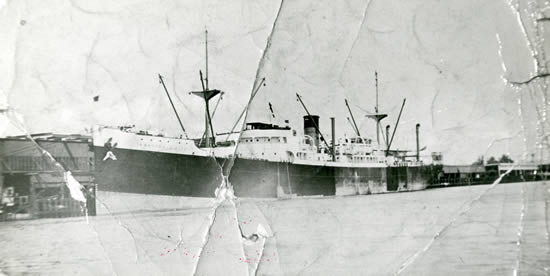
The Vancouver City sunk by a U-boat in the Atlantic. Raymond Keyse was lucky to survive.
In fact Ray Keyse had a lucky escape when he was nearly washed away from the lifeboat. Later he was to lose two brothers at sea Donald and Trevor. Trevor was on board the Anglo-Saxon when it was attacked by the ruthless surface raider Widder. The three of then had set sail in the same convoy. Ray was aboard the Avondean, and as well as Trevor, Donald went down on the ss Koranton.
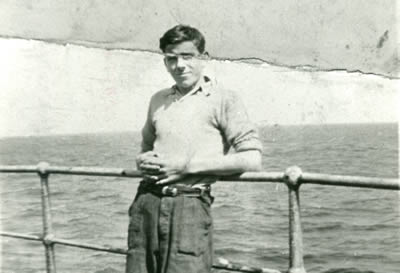
Trevor Keyse was one of those lost when the Anglo-Saxon was attacked by the ruthless surface raider Widder.
The next to go was the Kensington Court but luckily no crew were lost. Newport seaman Harold White later told the Argus how they had been picked-up by seaplanes.
The Conflict Continues
In early November the Arlington Court, packed with Newport boys, was caught by U 26 and sank. Aboard was George Swenson from Pill - at first reported missing presumed dead. He recalls it as a 'Jonah Ship.'
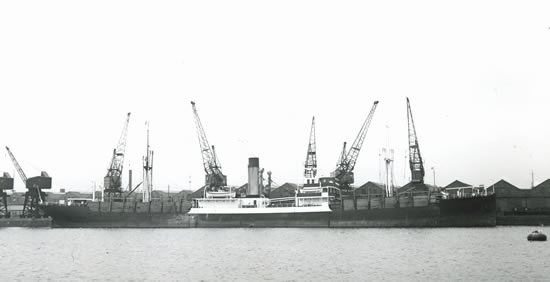
The Arlington Court - George Swenson from Pill recalls it as a 'Jonah Ship.'
Photo © National Museum of Wales.
'It had been laid-up in dry dock for years and was rotten. Conditions were dreadful and it was alive with rats and cockroaches. I was asleep when we got bumped but I was soon out and into the water. The rats were jumping off too and as we were pulling away in the lifeboat you could see the periscope of the sub circling the wreck.'
Before he finished with the sea in the ‘fifties, George was again torpedoed on the mv Brittany in 1943 and again in the CAM carrier Empire Morn off Cassablanca.
Ted Dyer (no relation) from Pill was a brave man who endured danger heroically when his ship was sunk in the Atlantic. He pretended to be an officer to protect the captain and was taken aboard the U- boat for questioning. He was made to swim back to the lifeboat. On another occasion he was aboard the ss Pampas, one of the few to struggle into Malta after heavy attack of the first convoy to reach there.
November indeed was a bad month for Newport when on the 25th the Royston Grange was sunk. Most of the crew were having dinner, including Ted Dyer, a seasoned and respected coxswain, and at least six other Newport men.
When war broke out one Gaer man was in Korea aboard the Glenmore loading flour and they had to make a run for Singapore. This was quickly followed by a harrowing voyage to New York via the Panama Canal. 'They said we would never make it. We were all alone; no convoys, no guns. Nothing. It took 75 days,' he told me.
Convoys
Ships out of the South Wales ports formed-up into convoys mainly off Milford Haven. Later they joined larger groups going to the south or north Atlantic or the Mediterranean.
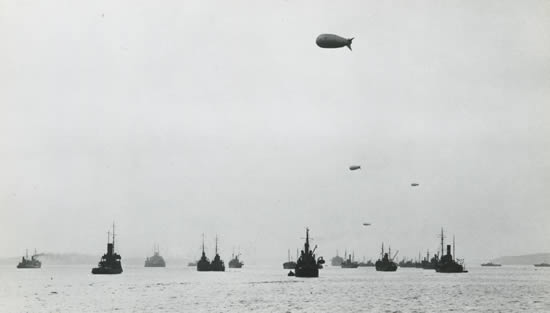
A convoy assembling.
Photo © National Museum of Wales.
Newport docks was a hive of activity with ships and seamen galore.
Later during the war the convoy system improved and ships were better protected by naval escorts. Nevertheless the dangers were still considerable and a lone ship unable to keep-up with the convoy was in perilous danger. Gaer man Henry Kelly, recalls his ship the Cragpool taking coal to Montevideo.
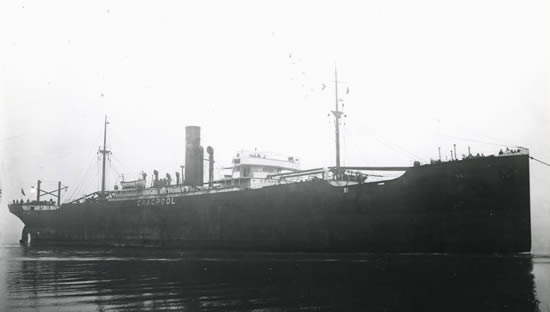
The Cragpool
Photo © National Museum of Wales.
'We broke down a few times and off the coast of Africa were nursed by the cruiser Londonderry. Eventually, we were told to leave the convoy as we were endangering the other ships. Left alone we continued to break down but incredibly we made it to South America.'
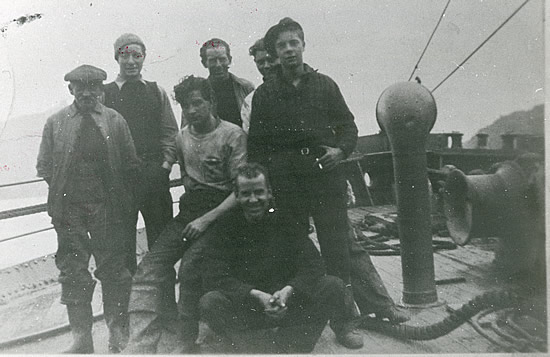
Henry Kelly's shipmates aboard the CRAGPOOL
Survival
Others though weren’t so lucky and were picked-off by U-boats. Once in the freezing water survival was a matter of luck - if lifeboats were near. One man described the scene when men were in the water. It is surprising therefore that some seamen came through the whole of the war without any serious events.
Others went in the water two or three times, or more. Despite the perils they had to face and the conditions they endured, they retained a sense of humour and always looked after each other.
'When at sea we worked together and we were all the same - religion, colour or class didn't count - we were all the same.'
And what of the Newport seamen?
'They were a great bunch' said Roy Little. When ashore they were devils but at sea they were superb. They were hard grafters and reliable. It is a fact that captains asked for Newport boys to crew their ships.'
Jim Dyer - 23 Dec 2011
NOTES
Article first published in South Wales Argus on 4th June 1987.